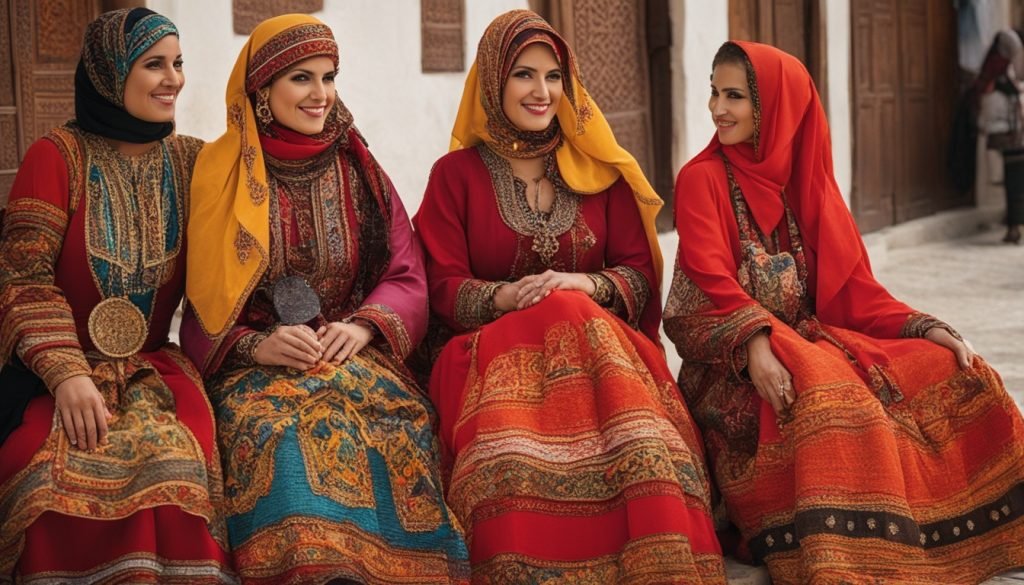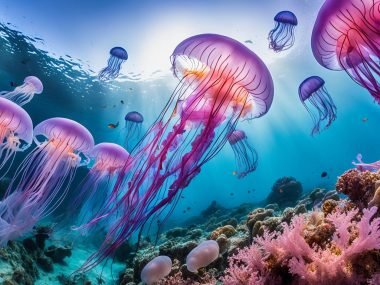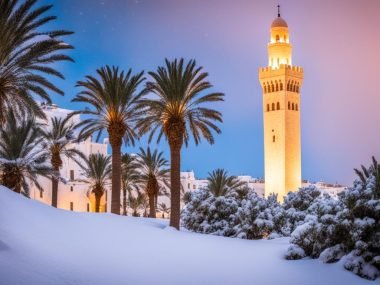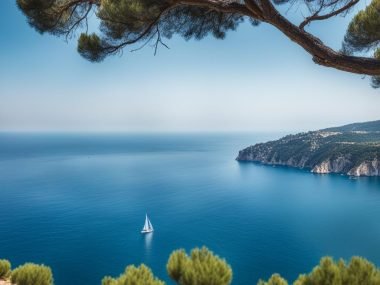Tunisia may seem small, but it’s the 91st biggest country worldwide. People often confuse it with being in South Africa.
But it’s not. Each country in Africa is unique. Tunisia proves that with its location and culture.
Tunisia is at Africa’s very top, named the Republic of Tunisia.
It lies next to Algeria and Libya, and the sea is to its north and east. About 11.7 million people live here, with Tunis as its capital.
Key Takeaways
- Tunisia is located at the northernmost point of Africa, not in South Africa.
- It is officially known as the Republic of Tunisia.
- Tunisia is bordered by Algeria, Libya and the Mediterranean Sea.
- The capital and largest city of Tunisia is Tunis.
- With an area of 163,610 km², Tunisia is the 91st largest nation in the world.
Geographic Location of Tunisia
Tunisia is at 34°N 9°E, in the northernmost part of Africa. It’s among the North Africa countries, linking Europe to Africa. Its location impacts its geopolitical and economic activities, due to its closeness to Sub-Saharan Africa and Europe.
Tunisia’s Position in North Africa
As a North African country, Tunisia has a distinct geographical spot. It’s next to Algeria to the west and Libya to the southeast. It has a long coastline along the Mediterranean Sea.
The sea brings a vibrant climate and beautiful coastlines. Tunisia acts as a gateway to Sub-Saharan Africa. Its spot highlights its cultural and natural beauty among North Africa countries.
Neighbouring Countries and Bodies of Water
Tunisia is neighbors with Algeria and Libya. This brings a mix of cultures and politics unique to North Africa. Also, it touches significant waters, like the Mediterranean Sea, with a 1,300 km coastline.
This coastline makes maritime activities and the tourism sector thrive.
The country’s geography is diverse, from the Atlas Mountains to Sahara Desert’s north. This variety shows its rich nature and strategic place in Africa.
| Feature | Description |
|---|---|
| Coordinates | 34°N 9°E |
| Borders | Algeria (west), Libya (southeast) |
| Bodies of Water | Mediterranean Sea (north and east) |
| Geographical Features | Atlas Mountains, Sahara Desert |
| Coastline | 1,300 km |
Understanding the Geography of South Africa
South Africa sits at the very bottom of the African continent. This country is full of different land types you won’t find in North Africa, like Tunisia. It has big flat lands in the middle, surrounded by rough hills and a slim coastal strip.
It’s known for having many types of living things and places. You’ll see dry deserts and green areas with lots of rain. South Africa’s varied land makes it special in Sub-Saharan Africa. It’s next to Namibia, Botswana, Zimbabwe, Mozambique, and Eswatini. It also has Lesotho right in its middle.
But South Africa isn’t just about earth and water. It’s also about the different climates and groups of people living there. This makes it very different from places like Tunisia in North Africa. South Africa shows how diverse and rich in culture Sub-Saharan Africa is.
A Historical Overview of Tunisia
Tunisia has a rich history. Many civilisations have shaped it over thousands of years. This history includes Ancient Carthage, Arab conquests, and the Ottoman era.
Ancient Carthage and Roman Influence
The city of Ancient Carthage started in 814 BC. It became a big trading centre in the Mediterranean. The Romans defeated Carthage in the Punic Wars.
Roman rule brought many changes. This included spreading Christianity and building grand structures. It was a key time in Tunisia’s history.
Arab Conquest and Ottoman Rule
The Arabs arrived and Tunisia became part of the Islamic Empire. Islam and Arab culture deeply influenced the country. Then, the Ottoman Empire took over.
Tunisia flourished under Ottoman rule, adding to its history. Turkish traditions mixed with local customs. These eras together make Tunisia what it is today.
Cultural and Demographic Insights into Tunisia
Exploring Tunisia’s culture and people shows us its wonderful history and mix of people. The nation’s past and present are seen in the mix of ethnic and religious groups. This gives us a look into the lives of Tunisia’s people.

Tunisian Ethnic Groups
Most people in Tunisia are Arabs, making up about 98% of the people. This shows how Arab culture shapes daily life. But, there are Berbers and others too, adding more colors to Tunisia’s culture. Berbers keep their own language and ways, especially in the south.
Religious Landscape of Tunisia
Almost everyone in Tunisia follows Sunni Islam. This brings people together across the country. Yet, there are some Christians, Jews, Shia Muslims, Bahá’ís, and people with no religion. This mix makes Tunisia’s culture even richer. The country is known for letting different religions live together peacefully.
| Demographic Aspect | Details |
|---|---|
| Primary Ethnic Group | Arab (98%) |
| Minor Ethnic Groups | Berbers and Others |
| Main Religion | Sunni Islam (99%) |
| Other Religions | Christians, Jews, Shia Muslims, Bahá’ís, and irreligious groups |
| Languages | Arabic (official), French (co-official in administration and education) |
In conclusion, Tunisia is full of cultural and religious variety. Its ethnic groups and many religions tell a story of a land where different cultures meet and live together.
Climate Comparison: Tunisia vs South Africa
Tunisia and South Africa have different climates. This shows how geography and weather shape them.
Mediterranean Climate of Tunisia
Tunisia has a Mediterranean climate. It has mild, rainy winters and hot, dry summers. This is clear along the north coast.
It affects how people live and farm. Tunisia is at Africa’s top. So, it has cool weather and good rain in winter. But the summers are hot.
This climate is key for farming, tourism, and daily life in Tunisia. It makes it stand out from South Africa’s varied climate zones.
Varied Climates of South Africa
South Africa has many climate zones. It ranges from dry deserts to wet, coastal areas. This makes it different from Tunisia.
Its east side is wet. This helps create green landscapes and many kinds of life. There’s also a Mediterranean area and semi-dry places.
South Africa is big, so it has many climates. This affects farming, business, and holidays.
| Aspect | Tunisia | South Africa |
|---|---|---|
| Climate Type | Mediterranean | Varied (Desert, Subtropical, Mediterranean, Semi-arid etc.) |
| Winter | Mild, Rainy | Variable (Cool in the interior, Milder on the coast) |
| Summer | Hot, Dry | Hot (Varies from humid to dry) |
| Main Influences | Mediterranean Sea | Varied terrain, Atlantic and Indian Oceans |
This shows how Tunisia’s and South Africa’s climates are different. Geography plays a big role in their weather, life, and culture.
Economic Profiles of Tunisia and South Africa
Tunisia and South Africa have different economic profiles. It’s important to look at how their economies are built. Each country specializes in certain areas and has different levels of variety.
Key Economic Sectors in Tunisia
Tunisia’s economy relies on a few important areas. Farming is key, with olives, dates, and citrus fruits being major exports. Mining and making goods, especially phosphate mining and textiles, are also big. The oil industry is a major part of Tunisia’s economy too.
Economic Diversification in South Africa
South Africa’s economy, on the other hand, has more variety. Mining is still important, making South Africa one of the top gold and platinum producers. But the economy also includes farming, fishing, food and drinks manufacturing, car making, and IT. This shows a wide range of economic activities.
Let’s compare the two in more detail:
| Country | Key Economic Sectors | GDP (PPP) Estimate 2023 | Per Capita |
|---|---|---|---|
| Tunisia | Agriculture, Mining, Manufacturing, Petroleum | $162.097 billion | $13,248 |
| South Africa | Mining, Agriculture, Fisheries, Food and Beverages, Vehicle Manufacturing, IT | Significantly larger and diverse | Varies widely by sector |
The Importance of Tunisia’s Geographic Position
Tunisia sits at the northern tip of Africa, making it very important. It’s close to southern Europe, right over the Mediterranean Sea. This spot is special in Northern Africa.
Tunisia’s place keeps boosting its economy and friendships with European and Arab countries. It’s near important sea paths, so it’s a key hub. This shows Tunisia’s big role in international groups.
Tunisia helps Northern Africa connect with the world by sea. This makes Tunisia more important. It plays a big part in the area’s economy, culture, and politics.
Is Tunisia In South Africa?
Some people wonder if Tunisia is in South Africa. Northern Africa region is where you’ll find Tunisia. It’s not in South Africa. South Africa is at the bottom of Africa. Knowing this helps us see how both places are special.
Tunisia is next to the Mediterranean Sea. It’s in the North Africa area with Algeria and Libya. South Africa is far to the south. It has a different weather, culture, and history. These facts show how varied Africa is.

Long ago, Tunisia was home to Carthage. It also felt the touch of Arab and Ottoman worlds. South Africa’s story is about European settlers and fighting apartheid. This shows more about how Tunisia and South Africa are different.
We learn from these differences. They show Africa’s wealth of cultures. Tunisia belongs to the Northern Africa region. It’s unique and not part of South Africa.
Tunisia’s Strategic Role in the Maghreb Region
Tunisia plays a big part in the Maghreb region as a member of the Arab Maghreb Union. It works closely with Algeria, Libya, Mauritania, and Morocco. The Union aims to increase economic ties, political steadiness, and cultural teamwork. Let’s look at Tunisia’s key role and its effects on African geopolitics.
- Economic Integration: Tunisia is key in boosting economic togetherness in the Maghreb countries. It’s working to make trade easier and improve economic teamwork.
- Political Stability: Tunisia helps keep politics stable in the region. It’s seen as a balanced force in African geopolitics. Its move to democracy after 2011 has inspired its neighbours.
- Cultural Collaboration: Tunisia and its neighbors celebrate their shared culture. This work helps unify them and keep their rich cultural history alive.
Tunisia’s spot on the map, between Sub-Saharan Africa and the Mediterranean, increases its diplomatic impact. This prime location boosts Tunisian relations with European and Arab countries. It shows Tunisia’s key part in North African geopolitics.
Tunisia is very important in the Maghreb region due to its many roles. It drives efforts for regional improvement and stability. These are crucial in the vast landscape of African geopolitics.
Comparison of Tourist Attractions: Tunisia and South Africa
Tunisia and South Africa are unique. They draw people in with history and stunning landscapes. Tunisia is perfect for those who love old ruins and buildings. South Africa wins the hearts of those who enjoy nature and animals.
Historical Sites in Tunisia
Tunisia is full of places that tell tales of the past. The ruins of Carthage show its ancient glory. The Great Mosque of Kairouan is also a wonder. It is very important in Islamic culture. These spots are treasures for those who cherish history.
Natural Wonders of South Africa
South Africa charms with its natural beauty. It’s great for outdoor fun. Table Mountain offers amazing views of Cape Town. It’s a hiker’s dream. Kruger National Park is a wildlife haven. You might see the Big Five here. The Cape of Good Hope is also stunning. It’s where two oceans meet. South Africa’s nature spots attract adventure seekers worldwide.
Both countries, Tunisia and South Africa, showcase amazing places. They have historical and natural attractions. These make them top spots for travellers.
Political Systems in Tunisia and South Africa
Tunisia and South Africa show different political ways due to their histories and cultures. Tunisia has a semi-presidential republic. It splits power between a president and a prime minister. On the other hand, South Africa uses a parliamentary republic model. This model shares political power differently. Each method shows how they manage government and democracy.
Tunisia’s Semi-Presidential Republic
In Tunisia, the government has a semi-presidential republic. The president and prime minister both have power. This setup aims for stability and good governance. For example, leadership under President Kais Saied and Prime Minister Ahmed Hachani shows this. They make policies together. This ensures checks, balances, and responsive governance.
South Africa’s Parliamentary Republic
South Africa, however, has a parliamentary republic. Here, the president is both head of state and government. This setup aims for unity and efficiency in executing policies. It balances power with parliament’s oversight. The president can make decisions with strong support from parliament. This ensures that policies match what the public needs and wants.
Common Misconceptions about Tunisia and South Africa
Some people think Tunisia is in South Africa, or the other way round. This mix-up comes from not knowing enough about geography.
Now, let’s look at the big differences between Tunisia and South Africa:
- Geographical Location: Tunisia is in North Africa, touching the Mediterranean Sea. It’s next to Algeria and Libya. South Africa is right at the bottom of the continent. It has Namibia, Botswana, Zimbabwe, Mozambique, and Swaziland around it.
- Cultural Distinctiveness: Tunisia’s history is shaped by many, including Phoenicians, Romans, Arabs, and the French. South Africa’s culture comes from Bantu people, Dutch and British rule, and its special ethnic groups.
- Climate: Tunisia has a Mediterranean climate. South Africa’s weather changes a lot, from desert to subtropical. This shows they’re very different places.
Knowing these facts helps clear up the confusion. It’s important to understand Tunisia and South Africa have their own special places in Africa. They are unique in where they are, their cultures, and their histories.
Conclusion
Tunisia and South Africa are far apart on the map. Tunisia is up in North Africa. South Africa is right at the bottom of the continent. They are different in many ways, including culture and history.
Learning about these differences helps us appreciate Africa more. Tunisia is famous in the Maghreb area and is close to the Mediterranean sea. South Africa has many types of weather and a big economy. This shows why each country is special in Africa.
Some people get confused and think Tunisia is in South Africa. But when we look closer, we see they are very different. Knowing more about them helps us understand and value Africa’s rich variety.







